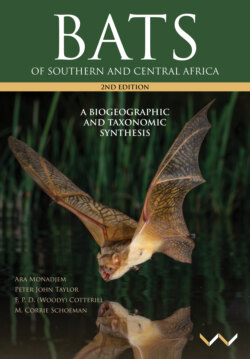Читать книгу Bats of Southern and Central Africa - Ara Monadjem - Страница 53
На сайте Литреса книга снята с продажи.
ОглавлениеCasinycteris argynnis Thomas 1910
Golden short-palate fruit bat
Least Concern
Description: Casinycteris argynnis is a small fruit bat with a mass of around 30 g. The broad muzzle is dog-like and distinctly shortened; the very thick, extensible lips resemble cheek pouches and emphasise the short snout of this species. The eyes are relatively large, their prominence accentuated by the yellow skin of the eyelids. The overall colour of the longish fur is russet-brown, with conspicuous greyish-white fur on the neck and belly and prominent white fur around the anterior bases of the ears. The skin of the large, rounded, vertical ears is similarly brightly coloured yellow or yellowish-brown. There are patches of white fur on the rostrum, above the eyes and anterior bases of the ears, with fur on the cheeks and lips paler, tending to white; this paler fur contrasts against the yellow skin of the nostrils, chin and lips, these brighter patches varying among individuals from orange to yellow; the brightly coloured reticulations on the wing membranes are a similar yellow or orange, and are most distinct on the skin around the finger joints. The bright skin pigment fades in museum specimens. The thumb is relatively long. There is no visible tail.
The skull has a domed braincase; zygomatic arches are relatively strong and prominent in dorsal view of the skull. The premaxillae are relatively well developed; the canines are relatively long, with short, broad, sub-circular molars; the post-dental palate is markedly reduced. There are two series of palatal ridges: one of three to four interdental ridges, in front of a ladder of crowded, thin post-dental ridges (13–16) (Andersen 1912a, Bergmans 1990).
Key identification features: Scotonycteris bergmansi has not yet been recorded from southern Africa (Hassanin et al. 2015), although it occurs only to the north of the region (van Cakenberghe et al. 2017). It is a smaller bat (FA < 56 mm) that lacks the white fur around the ears; the ears of C. argynnis are larger, and the eyelids, muzzle and reticulated wing membranes are often bright orange or yellow, but this pigment fades in museum specimens. The wing membranes of Scotonycteris are brown. Casinycteris opidion is a larger bat (FA > 75 mm) that also has not been recorded in southern Africa (Hassanin et al. 2015). The palate of C. argynnis ends at the level of the upper molar teeth, and the upturned rostrum is correspondingly shorter. The orbital cavities are larger; the zygoma, postorbital processes and cranial ridges of the skull are more strongly developed compared to Scotonycteris (Bergmans 1990).
Echolocation call: This bat does not echolocate.
Distribution, habitat and roosting: Casinycteris argynnis is restricted to the main forest belt, with scattered records that extend its equatorial range across the Congo basin to the western edge of the Albertine Rift. Records are associated with Guinean–Congolian lowland rainforest, swamp forest, and rainforest–grassland mosaic. Three specimens from the southern Congo basin extend its range as far south as Kananga (= Luluabourg) at ∼6°S in the DRC. The type specimen is from Bitye, Cameroon (BM 11.5.5.1).
Little is known about its roosting behaviour. Lang and Chapin (1917) described a solitary individual roosting in a tree.
| External and cranial measurements (mm) and mass (g) for Casinycteris argynnis, males and females presented separately | |||||||||||
|---|---|---|---|---|---|---|---|---|---|---|---|
| Mean | Min | Max | SD | N | Mean | Min | Max | SD | N | ||
| Males | Females | ||||||||||
| Mass 1 | 26 | - | - | - | 1 | Mass 1 | - | 28.5 | 33.0 | - | 3 |
| FA 1 | - | 49.8 | 54.9 | - | 10 | FA 1 | - | 54.4 | 63.5 | - | 13 |
| Total | - | - | - | - | - | Total 2 | 95.0 | - | - | - | 1 |
| Tail | - | - | - | - | - | Tail | - | - | - | - | - |
| Tibia | - | - | - | - | - | Tibia | - | - | - | - | - |
| Ear | - | - | - | - | - | Ear | - | - | - | - | - |
| CI 1 | - | 21.8 | 23.9 | - | 3 | CI | - | 24.0 | 26.7 | - | 11 |
1 Bergmans (1990)2 Thomas (1910)
Extralimital: Known from four localities in eastern Cameroon, in addition to the total of eight localities in the DRC (Bergmans 1990).
Foraging ecology: There is no information on the diet or foraging behaviour of this species, although it is frugivorous.
Reproduction: No reproductive information is available.
Figure 46. A specimen of Casinycteris argynnis from the eastern Congo (© W. Bergmans).
SYSTEMATIC NOTES
1910.Casinycteris argynnis O. Thomas, 1910 Ann. Mag. Nat. Hist. ser. 8, 6: 111. Bitye, Cameroon.
This rarely collected species represents a monotypic genus with distinct morphological characters that distinguish it from all other Pteropodidae (Bergmans 1990).
1 Bergmans (1990)
2 Thomas (1910)
